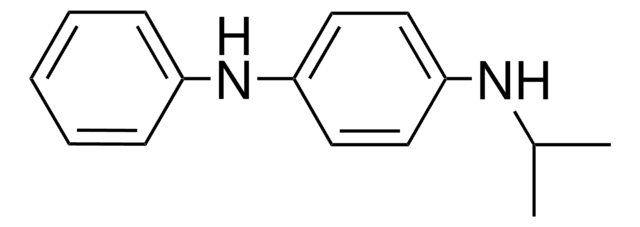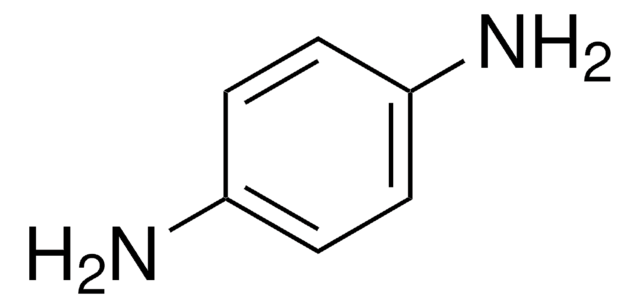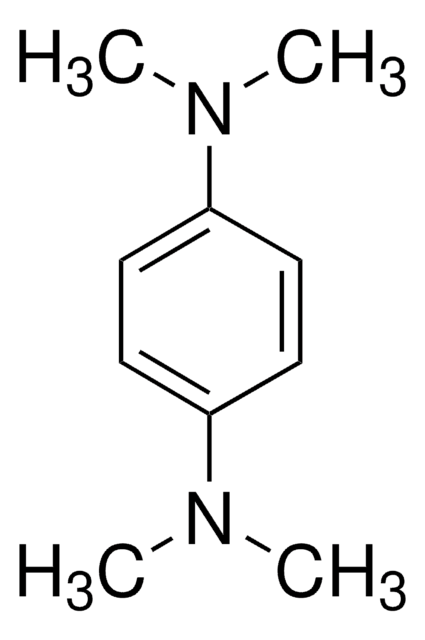292265
N,N′-Diphenyl-p-phenylenediamine
98%
Synonym(s):
N,N′-Diphenyl-1,4-phenylenediamine
Sign Into View Organizational & Contract Pricing
All Photos(3)
About This Item
Linear Formula:
C6H5NHC6H4NHC6H5
CAS Number:
Molecular Weight:
260.33
Beilstein:
2215944
EC Number:
MDL number:
UNSPSC Code:
12162002
PubChem Substance ID:
NACRES:
NA.23
Recommended Products
Quality Level
Assay
98%
bp
220-225 °C/0.5 mmHg (lit.)
mp
143-145 °C (lit.)
SMILES string
N(c1ccccc1)c2ccc(Nc3ccccc3)cc2
InChI
1S/C18H16N2/c1-3-7-15(8-4-1)19-17-11-13-18(14-12-17)20-16-9-5-2-6-10-16/h1-14,19-20H
InChI key
UTGQNNCQYDRXCH-UHFFFAOYSA-N
Looking for similar products? Visit Product Comparison Guide
Related Categories
Application
- TPA-induced inhibition of gap junctional intercellular communication is not mediated through free radicals.: This research explores the role of N,N′-Diphenyl-p-phenylenediamine (DPPD) in cellular communication, providing insights into its applications in high-performance rubber stabilizers and life science manufacturing chemicals. (Hasler et al., 1990).
Signal Word
Warning
Hazard Statements
Precautionary Statements
Hazard Classifications
Aquatic Chronic 3 - Skin Sens. 1
Storage Class Code
11 - Combustible Solids
WGK
WGK 1
Flash Point(F)
Not applicable
Flash Point(C)
Not applicable
Personal Protective Equipment
dust mask type N95 (US), Eyeshields, Gloves
Choose from one of the most recent versions:
Already Own This Product?
Find documentation for the products that you have recently purchased in the Document Library.
Customers Also Viewed
Xiaobo Ji et al.
Analytical sciences : the international journal of the Japan Society for Analytical Chemistry, 23(11), 1317-1320 (2007-11-14)
The oxidation of N,N'-diphenyl-1,4-phenylenediamine (DPPD) has been studied by cyclic voltammetry at glassy carbon electrodes in propylene carbonate. Next, the reaction between ammonia and DPPD was similarly investigated. It has been shown that ammonia reversibly removes protons from oxidized DPPD
Yoshiko Kawai et al.
Journal of pharmacological sciences, 111(4), 433-439 (2009-12-08)
Cisplatin causes chronic interstitial disease with fibrosis, but the development mechanism of interstitial fibrosis is not yet understood. We examined the effect of an antioxidant, N,N'-diphenyl-1,4-phenylenediamine (DPPD), on development of interstitial fibrosis induced by cisplatin. Cisplatin increased blood urea nitrogen
Sung Min Park et al.
Pharmacology & toxicology, 92(1), 43-50 (2003-04-25)
This study was undertaken in order to examine the roles of lipid peroxidation and poly (ADP-ribose) polymerase (PARP) activation in oxidant-induced renal cell death. Opossum kidney cell cultures were used as the renal epithelial cell model, and an inorganic hydroperoxide
Florian Seyfarth et al.
Journal der Deutschen Dermatologischen Gesellschaft = Journal of the German Society of Dermatology : JDDG, 7(9), 770-772 (2009-04-24)
A ten-year-old boy presented with recurrent eczema on the dorsal of both feet and the thighs. His symptoms became worse when he used racing swim fins. Patch testing included the standard, ointments, preservatives, leather, textile dyes, rubber component, and corticosteroid
Stefania Miccadei et al.
Nutrition and cancer, 60(2), 276-283 (2008-04-30)
Cultured rat hepatocytes and human hepatoma HepG2 cells were used to evaluate the hepatoprotective properties of polyphenolic extracts from the edible part of artichoke (AE). The hepatocytes were exposed to H2O2generated in situ by glucose oxidase and were treated with
Our team of scientists has experience in all areas of research including Life Science, Material Science, Chemical Synthesis, Chromatography, Analytical and many others.
Contact Technical Service











